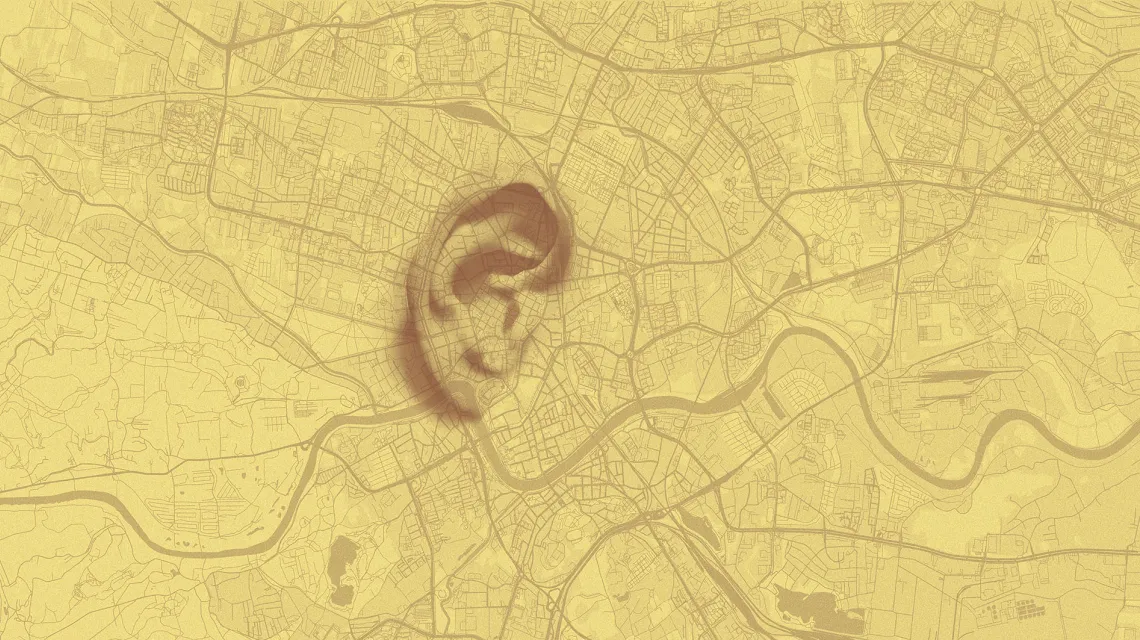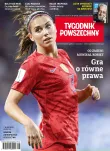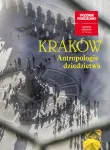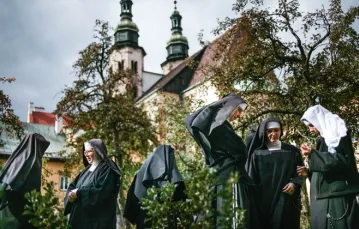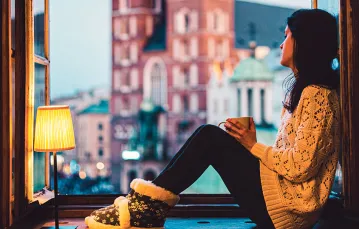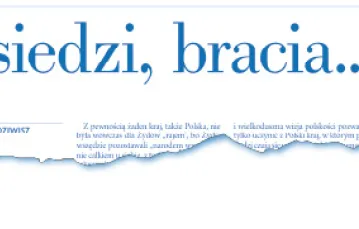Wykupienie dostępu pozwoli Ci czytać artykuły wysokiej jakości i wspierać niezależne dziennikarstwo w wymagających dla wydawców czasach. Rośnij z nami! Pełna oferta →
MICHAŁ KUŹMIŃSKI: What does Kraków’s Market Square sound like?
MAGDALENA WADOWSKA: Many visitors see it before they hear it. Most of us listen to the Market Square unconsciously: we take the sounds that surround us matter-of-factly. It’s only when I interview passers-by on the Market Square and ask them about what they hear that their conscious processes kick in. The bugle-call from St Mary’s and the clip-clopping of horse-drawn carriages, or droshky, are there in the foreground for sure, but the Market Square is, in essence, a humming noise; or rather a voice – a multicoloured, multilingual sound.
Could Kraków be recognised by its voice?
The bugle call would be a giveaway. Everyone in Poland is familiar with the tune as it is the only bugle call that has been played from the middle of the 19th century until today. Kraków does not only resonate with the sound of pigeons and horse-drawn carriages on the Market Square or women's high heels. There are also church bells. And tourists.
You mean the crowd?
And a cacophony of voices. When we speak, each of us creates his own melody and contributes to the common sound space.
How has the city been transformed by a new wave of tourism that brought new languages, including those that we don't understand?
When I talked to my mother about the 1960s and 1970s, she said that the Market Square was an empty, quiet and dark place at that time, and that social life was centred on the Planty Park where people would go for wander to chat. And the Market Square was thoroughly Polish, with just the odd Latin or French phrase heard now and then.
I like it that there are more and more languages today because it makes things so much more diverse. And the soundscape is being transformed and broadened. But older people sometimes tell me that they feel lost among the plethora of new languages. Locals often purposefully bypass the Market Square, preferring the side streets.
I remember the wonderful violinist, Stefan the Gypsy, who performed by the St Florian Gate or St Mary's Church. To this day I recall Gienek Loska: he played his guitar in Sienna Street, but I could hear him as far as Szewska Street. And I miss Maciek Maleńczuk, who sometimes performed by the Cloth Hall... But those were the days when they had no competition, unlike now.
I also remember Robert Pieculewicz's electric guitar by the Town Hall Tower.
Sounds can be missed, too. Then came the years when the Market Square swarmed with performers – from accordionists to musicians playing on glass tumblers. There were drummers usurping the whole sound space and also breakdance performers. And then the city authorities decided that street musicians had to vetted by a special commission. This is when they began to have a say on what the Old Town’s soundscape should be like. Is that natural?
I’d rather not answer that. The window in my office on Wiślna Street overlooks the Planty Park and I’ve lost count of the number of times I’ve been tormented by street musicians. If you were made responsible for the Old Town’s acoustic environment, how would you put together Kraków’s soundtrack?
For me, it’s rather a collage of many overlapping soundtracks, like in a programme for an editing audio. Interestingly, this acoustic collage has a different sound depending on the time of day and the season. It’s in a major key one time and in a minor key the next. And sometimes it just plays in tune with our souls.
The city is throbbing with life – and with sound. So it’s only natural that the way the city sounds changes every second because the sound as such plays out very quickly. You can listen to a city from different angles and perspectives. I have no idea what such a soundtrack should be like. I just accept it as it is and listen with interest to how it changes and develops.
But, in a city, the private sphere often overlaps with the public sphere, also through sound. Trams would be one example...
When travelling by tram in the early morning, I feel comfortable because my fellow passengers are still nodding off. But it’s different late in the afternoon when people are returning from work and talking on their phones, making me inadvertently privy to their intimate conversations. Strangely, a person sitting next to me is not at all bothered about invading my space – with sound.
On the other hand, we live much closer to each other in the city, so we can also hear each other, as the residents of tenement houses and apartment blocks know only too well. People are increasingly detached from the public sound space. They cut themselves off from it and create their own space by putting on headphones. Trams are often an experience between the two extremes: there is either dull silence because everyone has headphones on, or there is someone who makes everyone listen to their problems – because problems are usually what they are talking about. The personal invades the public and the public invades the personal.
In a city, the sacred also invades the profane and the profane invades the sacred. Is this also true in terms of sound?
On 11 November I went to the Market Square to record the singing of the national anthem near St Mary’s Church. It was a solemn and moving occasion. But by the Town Hall Tower there was a concert organised by one of the radio stations. As the Polish anthem was being sung in one corner of the Market Square, a pop performer was being called to the stage in another corner. The division into what is sacred and what is profane is flexible and changeable, also in the sound space.
An interesting example, because I was rather expecting you to talk about disturbing the pious silence associated with the sacrum.
Sacred places are located in the public space. Chapels, memorial sites, alleys... the Corpus Christi and Three Kings’ processions. The sacrum is not always silence; in a sublimely quiet gothic church, the sacred space is filled with the sounds of chants and prayers during mass.
And the ringing of church bells. It is difficult to imagine a sound more closely associated with both the sacred and the city. Yet the ringing of bells in a parish church adjacent to a housing estate does not necessarily awaken pious thoughts at six in the morning.
On Kraków's housing estates there have been protests against the ringing of bells. In the Old Town, by contrast, bells are not regarded as a nuisance but as something as natural as the rattling of a tram. As you walk along the Vistula boulevards on a Sunday, you follow the cascade of bells from the Skałka Church through Dębniki to Salwator. All this is combined with the sound of cars moving along Konopnicka Street and the babble of the Vistula. This is also part of Kraków’s soundscape.
But the bells don’t just ring to call the faithful to mass. Historically, they rang to warn of danger or to announce solemn events.
Like the Sigismund Bell.
In my childhood, when it was known that the Sigismund would be ringing, we would hurry to Wawel Castle to be as close as possible to its sound. This is the bell that reminds me of my childhood. Now I take my son to Wawel Castle. The Sigismund has a solemn sound, but for me it is also incredibly warm. The way in which sounds are perceived is unique to each of us. It's my legacy, my identity. Bells are one of the few sound monuments that have survived to this day. They form a kind of a natural sound archive.
For me, the sound of the Sigismund Bell is still the bearer of bad news: when we hear it in our press room, we nervously check the news.
I felt the same on 12 May during the St Stanisław procession – I forgot what day it was, and when I heard the bell, I wondered if anything bad had happened.
What makes the sound of the bell so strongly associated with the sacrum?
Exactly, what does it sound like? Powerful. It's a vibration of enormous impact. The bell stands for power. Its sound penetrates the whole neighbourhood, a bearer of information. It instils a sense of both beauty and fear.
Let us move to Kazimierz. I would like to ask you about sounds as a lost legacy.
As I perceive the world primarily through sound, I have a problem with Kazimierz. Today it is filled with the sound of partying. And I know from people who remember pre-war times, whose memories I have recorded, how differently Kazimierz sounded at that time. Today, this former Jewish district is impoverished when it comes to sound. There are no sounds that could define its identity. I can sense a state of auditory anxiety there.
On the other hand, groups of young Jews are bringing completely different sounds to the area, for instance, when they stop to eat and chat on Heroes of the Ghetto Square; the rustling of sandwiches, salads, and drinks being unwrapped pervades the area. They are creating a new sound pattern of that place.
Alive. Leaving aside the dignity of the sounds we are talking about, the city has a right to be noisy, doesn't it?
Town squares used to serve as markets, after all. When I think about the Cloth Hall from seven hundred years ago, I imagine the hustle and bustle that must have prevailed here. Looking at the crackows, boots, panniers and small objects preserved from those times, which can be seen at the exhibition underneath the Market Square, I can almost hear the sound they made: loud and coarse. A city must be noisy.
In Old Jerusalem, the Way of the Cross –fundamental to Christianity – is experienced amongst the buzz and bustle of Arab souks. Does Kraków have its own heritage of noise? A noise that should be protected as a cultural asset?
But where in Kraków is it still genuinely noisy? The Cloth Hall is serene, while the area of the Old Town has become commercialised and primarily serves a representative function.
The Market Square becomes noisy during Christmas and Easter, when it turns into one big festive market. For me, Floriańska and Szewska streets are noisy every day, and I tend to avoid these acoustic tunnels. But for someone else they may be not noisy at all. The Stary Kleparz market is loud, noisy, and acoustically attractive on Saturdays. You can hear the dialects of villagers from around Kraków, the highland dialect, the characteristic Cracovian drawl, and foreigners’ cries of admiration. But let's move further from the centre to Nowa Huta, where until recently industrial noises could be heard. A colleague of mine from the radio station once did a piece on the Gdańsk Shipyard, where all those industrial sounds sounded like bells. Has anyone ever documented the sounds of the Nowa Huta steelworks? It’s also part of the city’s heritage.
Those living close to the steelworks would probably beg to differ. How can the fact that noise is an inherent part of a city be reconciled with the inhabitants’ right to peace and quiet?
By providing noise-free zones. I love the courtyards of tenement houses. They are called ‘podworce’ in Cracovian slang. There, even though it’s only three minutes from the Market Square, I hear the city in a completely different way, as if in the background. The way the city sounds is distant and gentle, and in no way noisy. Sometimes I also take refuge in university or priory gardens, where I can enjoy peace and quiet while still being in the city, although the silence there is not absolute.
Noise in the heart of the city comes from people and their voices. You can also hear the sounds made by electric sightseeing carts, and I mean here the pre-recorded legends of Kraków that they play as they travel through the city. And there are also carry-ons: wheeled suitcases rattling on the cobblestones.
There were rumours that Venice considered banning them.
But nowadays they are also an element of Kraków. Mornings in the city resound with the noise of rubbish trucks and carry-ons.
Are you saying that there is no such thing as absolute silence these days?
Instead of silence there is the hum from the appliances that surround us, such as air conditioning and computers. On the other hand, people who used to contribute to the soundscape by touting their services with their own voice no longer exist. There is one lady left: she sells postcards and peacock feathers and can be heard singing now and then. I still remember bagel sellers calling out to passing customers. Oh, wait, now the calling out is done by the women who drive the horse-drawn carriages.
And farmers used to come to the housing estates and advertise their produce by calling out: ‘Potatooooes’.
Today we are embarrassed to make noise.
Why? I mean, the bagel sellers are still here, but they're silent.
Maybe they think it’s inappropriate to shout? Perhaps they feel embarrassed? And yet in the city we are looking for local colour, for the most important things, also in acoustic terms. Someone might ask: what would the Market Square sound like if we were free of the burden of embarrassment, just as children, students, and tourists are, especially those from the UK? Some people are looking for sonic harmony, while for others it is of no importance.
On the other hand, these days we no longer talk to strangers on a bus or tram. We isolate ourselves from the world outside by putting on headphones or immersing ourselves in our smartphones.
Perhaps there will come a time when we will miss the natural sounds of the city that determine its identity? Or is this just nostalgia? A made-for-tourists acoustic folklore?
The chirping of clay birds or the clacking of wooden toys, but also the sounds made by new kinds of squeaky rubber toys, plastic dragons, and barrel organs, would fall into the category of artificial acoustic folklore. Besides, I think that each of us has his own personal sound diary. The sounds that fill this diary depend on many factors. It is enough to listen to what sounds resonate with us, what makes our acoustic identity. For me, this could be a melody of bells, and for a friend of mine – a song by Grzegorz Turnau or the fountain on Szczepański Square.
Besides, what exactly are the natural sounds of the city like? Today, these are car horns, ambulance sirens and, for example, the sound of pneumatic drills from the countless repairs going on around the city.
I'm asking about natural sounds because we’ve talked a lot about sounds that have been replaced by commercial sounds: parties and concerts instead of religious ceremonies and markets.
But there is nothing wrong with acoustic events: today they form the city’s natural soundscape and bring people together. In the evenings the Market Square is alive with the sound of glasses, cutlery, conversations, laughter, and the occasional quarrel. And this is also beautiful, vibrant – and natural. The sounds of the Galeria Krakówska Shopping Mall are torture for some people and music to the ears of others who could spend hours immersed in it.
The sound of the city is alive and changing. It is important that we are aware of our contribution to the city’s soundscape and that we feel responsible for it. Because we rarely think about sound, and all too often we drown each other out.
Interview by Michał Kuźmiński
MAGDALENA WADOWSKA is a radio journalist and reporter. A soprano singer and ethnologist by education, she won the Grand Press Award in 2013 in the category of Radio Reportage. She is the author of the phonosphere at the Maps of the City exhibition.
KRAKÓW. ANTROPOLOGIE DZIEDZICTWA – CZYTAJ CAŁY DODATEK SPECJALNY >>>
KRAKOW. ANTHROPOLOGIES OF HERITAGE – READ MORE IN ENGLISH >>>


